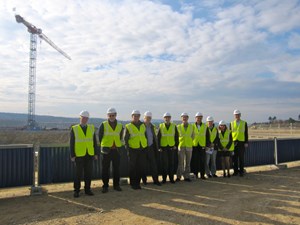ITER NEWSLINE
201
FuseNet—preparing the next fusion generation
Mark Scheffer, FuseNet Executive Board
FuseNet—preparing the next fusion generation

With a stop at the edge of the 17-metre deep Tokamak Pit, the FuseNet delegation was eyewitness to the impressive construction works. A bit of imagination ... and the shape of the Tokamak could already be recognized in the seismic isolation pads.
At the end of November the Executive Board of FuseNet—the European Fusion Education Network—met in Cadarache. The FuseNet project, launched three years ago and funded under the Seventh Framework Programme (FP7), brings together 36 European universities and Euratom associations from 18 countries.
"FuseNet was founded to coordinate and improve fusion education in Europe, to prepare the next generation of fusion engineers and scientists," says FuseNet Chairman Niek Lopes Cardozo. "Until now, we have worked with many universities and fusion labs, but it is important that industry become involved in the education process much more than before. Because—as we can see in ITER—industry is now a determining factor in the development of fusion power. FuseNet is keen on developing this interaction between fusion industry and academia for education."
FuseNet aims to improve the quality and attractiveness of fusion education by providing hands-on experiments to students and supporting joined educational activities.
"But we also offer individual support to students and have established European-wide, ambitious criteria for the award of fusion science and technology Master and PhD certificates," explains Lopes Cardozo. "FuseNet enhances the attractiveness of fusion to students by offering high quality learning opportunities. But, of course, the coolest attractor is ITER itself. This experiment—its dizzying scientific and technological challenges as well as its international dimension—appeals strongly to our best students."
With a stop at the edge of the 17-metre deep Tokamak Pit, the FuseNet delegation was eyewitness to the impressive construction works. A bit of imagination ... and the shape of the Tokamak could already be recognized in the seismic isolation pads.
"It is an inspiration to see the ITER Project materializing here on site. What we see is the construction of career prospects for the present generation of students! Our students can visit the ITER site today and realize that tomorrow they may sit in the control room and be the operator of this fantastic experiment."
Visit the FuseNet website here.
return to Newsline #201


